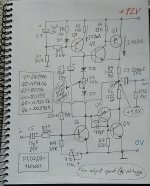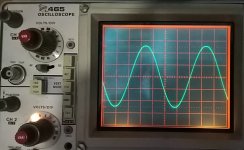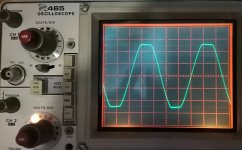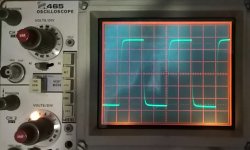dosent change the fact spare power and gain is usefull, im talking more about 5W/10W rather than 50W/100W
Here is modified 'a simple one-watt amp' this could be named 'Return of red Led' also there is two more transistors one 2N3904 & 2N3906 and some other parts, still quite simple and sounds maybe little bit better than simpler version. Can say this after two days listening . 100kOhm NTC resistor at Q6's base improves DC stability at point A, can be useful if ambient temperature changes.

Attached is also the another simple schema using 6 transistors.
Now there is two different regulators and two amps. Also a lot of different buffers & preamps...
Attached is also the another simple schema using 6 transistors.
Now there is two different regulators and two amps. Also a lot of different buffers & preamps...
Attachments
Thanks 'lineup'.
Maybe this one also could be easily simulated ? (NTC resistor is not important for simulation, use standard 100K resistor). You just have simulated version before this which is almost same.
Maybe this one also could be easily simulated ? (NTC resistor is not important for simulation, use standard 100K resistor). You just have simulated version before this which is almost same.
Hi @No ideas , the operation point of that simple buffer is not working too well. It cannot handle much more than 0.5V input and has way too high THD.also here is a basic volume pot buffer
Check the above circuit in the attached spice file how small changes improving it a lot.
THD of the upper at 0.5V input is 0.11% vs. 0.88% of the original. Also the improved one has a much more desirable distribution of harmonics.
Attachments
Some measurements, amp from messages #263.
First pic is 1kHz sine just when clipping starts (load 8ohm resistor) this gives 1.5W output power , more than version before this. Next pic shows symmetric clipping. 10kHz square wave is quite clean and last one is 50kHz sq.
Freq response : 100kHz is 0.2dB down versus 1kHz.
First pic is 1kHz sine just when clipping starts (load 8ohm resistor) this gives 1.5W output power , more than version before this. Next pic shows symmetric clipping. 10kHz square wave is quite clean and last one is 50kHz sq.
Freq response : 100kHz is 0.2dB down versus 1kHz.
Attachments
Here is something with only three transistors but based to PLH amp by Nelson Pass, all done with cheap BJT:s no Mosfet's here.

now im just intrested in the pcbs for these amplifiers, i believe we should try to run it at 15V
Big distortion isn't a big surprise, but this one sounds good. Maybe high amount of 2nd harmonic makes this. Previous 8 transistor design measures much better, these simple designs can't be so good.
Some one-sided PCB can be done later.now im just intrested in the pcbs for these amplifiers, i believe we should try to run it at 15V
I forgot the degeneration resistor in my simulation, so the results are actually slightly better: 0.45% and 1.59% respectively.
With the bias voltage set to 5.9V I got the distortion down to 0.24% @ 0.1W. But you have to be careful with the current through the MJE340s! I'm seeing 570mA, which is more than the 500mA they're rated for. And that's at idle. It's peaking at 620mA!
Measured current trough output trannies is under 300mA in my protos which is not enough. Here simulation lies little bit. No distortion measurements, but done some LTspice sims today using 2N3055 output trannies using original schema. With 2N2907 & 1N4148 current mirror can get 0.13% dist @1W output to 8ohms, max output power 1.5W @0.5% dist, all these from sims. R2 must be 100K and R1 = 10K, for lower dist. try these values.
Question is : why use 8 trannies if 4 and 1 diode seems to be enough ?
Question is : why use 8 trannies if 4 and 1 diode seems to be enough ?
dosent the class A amplifier have only 2 transistors or is the extra transistor a part of a preamp section
Im personally waiting, although at this point just build the jlh1969. The extra transistor is better spent on a feedback loop rather than a constant current source.
- Home
- Amplifiers
- Solid State
- A simple discrete one-watt amplifier




